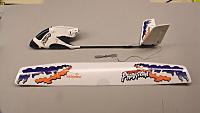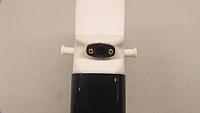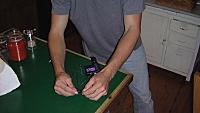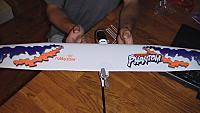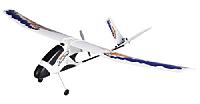|
|
|||||||||||||||||||||||
|
Thread OP
|
Hobbyzone Firebird Phantom RTF ReviewIntroduction
The Phantom Firebird has been released for several months and I was happy to get the opportunity to review this great little trainer aircraft. The Firebird Phantom is the introductory model in a line of great products that includes the Freedom Commander2, Aerobird Swift and Aerobird 3. Each of these great aircraft have features worth exploring, and with this line you can gradually work your way up to becoming a very proficient flyer. You have to give Hobbyzone credit for producing the Firebird Phantom, an airplane full of advanced technology at such a great price. The Phantom comes complete with all the necessary components of a true RTF plane along with one of the best information packages available. I have also provided a narrative of my daughterís boyfriend as he processes his very first experience in radio control flight to give you a good picture of the possibilities the Phantom brings to this hobby in the area of trainers.
Kit Contents
The Phantom arrived in great shape, packaged in a foam shipping container that protected it well. You can also use the container to carry the plane in the car if you want to take some time at lunch to do some park flying.
Kit Includes:
Fuselage
As you would expect from an RTF the Phantom comes complete with the radio, Anti-Crash Technology (ACT) and motor installed.
The wing easily attached with rubber bands. You might need to stretch the bands a little before you put them on and get some help with holding the plane as this is easier than wrestling the rubber band and fuselage by yourself. That is really the only build step for the Phantom.
Tail
The tail is complete and nothing needs to be done. The pushrods exit the tail boom through the top, and this exit point has been reinforced.
Preparation and Setup
There are a few things you need to do prior to flight. First you will need to drain the NiMH 7-cell 8.4V 300mAh NiMH battery, and then slip the prop on. After installing the transmitter batteries, turn on the transmitter, and then plug in the NIMH battery. Use the throttle stick on the left and hold the throttle stick down for one second to arm the receiver, and then run the motor until it has cycled down and the prop stops spinning. Let the battery cool for a few minutes, and then plug in the charger and charge the battery. While this is going on take some time to read through all the literature and watch the video.
ACT - Anti-Crash Technology
With sensors located above (looking forward) and below (looking backwards) you have a high tech system installed that will keep you out of trouble if you follow the recommendations. ACT, or Anti-Crash Technology senses the ground and extreme attitudes that might put your plane in danger. If you enter a steep dive, the ACT will correct the dive and return the Phantom to level flight. Other things will also happen that will tell you the ACT was engaged. When checking control surfaces, if you experience only one control surface moving that is because the ACT is turned on. Move the stick in the opposite direction and now the left control surface should be down and the right one up (ACT off). The Phantom has been preset at the factory so you really should not have to make any adjustments.
Look also for:
Notice the last item, but donít worry, the plane is in level flight and under control. You will need to release the sticks to regain control.
ACT System Limitations:
You can also turn off the ACT. This is simple to do and after a few successful flights you will likely want to do this even before you launch. To turn off the ACT, push down (in) the right stick, and the power light will start flashing indicating the ACT is off.
Flying
My experience with the Phantom was great. It was easy to fly, but was also fast, especially downwind. I found it was easy to turn back into the wind, so I never had any problems with feeling like it was getting away from me.
Basics
The Phantom in the factory configuration is not an aerobatic plane. You can enter a dive and pull up into a weak loop, but the top of the loop tends to stall out. Stalls were very gentle. Because the Phantom is light, and because it has dihedral, the stall is pretty much just a drop of the nose with no recovery problems. Otherwise I liked flying the Phantom both with the ACT on and off. At full throttle the flights were short and less than 10 minutes, but by applying some throttle management I could keep the plane in the air much longer. The plane performs like a glider in wind and will almost hover in place. It is fun to fly a fast downwind and then a slow upwind.
Taking Off and Landing
I think you will likely prefer the hand launches. There are light wire landing gear you can use on hard surfaces, but the roll out is short, and the landing is short so the wheels never really roll that much. The hand launch is easy, and the Phantom climbs out nicely. I never had to even do any trimming to speak of. The plane tracked straight and had no unsavory characteristics. Landings were also easy to accomplish and take about five to ten feet to touch down and stop. I thought the planeís control exceptional in the glide and did not want to tip stall or balloon on approach.
Aerobatics/Special Flight Performance
There are no aerobatics to speak of in the factory setup configuration, but you can change the linkages by moving the linkage from the outer control horn hole to the inner hole for more movement of the control surfaces. With that change you can do some loops and tail slides.
A Beginnerís Perspective
Meet Ryan, a total novice, my flight filming tech and my daughterís boyfriend, in his first RC flight! Ryan was hesitant, but with a little encouragement, he made the leap. He had been taking video of me for another project, but decided to let me have the camera for his maiden. I had previously flown the Firebird Phantom to make sure it was trimmed correctly. He handed me the camera, and I gave the plane and transmitter to Ryan. We made sure the anti-crash technology (ACT) was turned on by pushing the right stick down. If the red light is steady, the ACT is on. If it is flashing, you have turned it off. There are some great benefits in using the ACT. First, ACT sees the horizon and reduces the throttle and adjusts the attitude if the plane gets into a dive or a spin. Note: you must be at least 150 feet above the ground for it to work. To return control back to the pilot, just let go of the sticks. Ryan never even activated the ACT. He successfully kept the Phantom level and in control. We did have some wind, and both of us determined the best way to handle the Phantom was with shorts bursts of the throttle. I believe that with the throttle on all the time, the plane can move a little too fast for a novice... especially someone that has never flown! I stepped in for a landing for Ryan, but I really believe he will soon be ready for that maneuver. There is no doubt that Ryan was satisfied with his first flight. I don't know if he is hooked, but he was able to do what he set out to accomplish: solo fly a radio control plane. I think anyone can do the same with the Phantom, but some support is necessary. I was impressed that at one point he said, "Hey, when it is coming right at you the control are backwards." He was getting it!
Flight Video/Photo Gallery
Downloads
The Solo Flight! 5.69 MB
Is This For a Beginner?
Yes, it is perfect for beginners who have some help. The Phantom flies well and is very durable.
Conclusion
This is a great plane with lots of technology at a great price. I have no reservation in recommending the Phantom; itís a great value with well written instructions and a well designed airframe and is crash resistant. You also get a product from a great company that is responsive to customer input.
Pluses
Negatives
ImagesView all Images in thread
|
||||||||||||||||||||||
|
Last edited by Angela H; Dec 28, 2007 at 03:10 PM.
|
|||||||||||||||||||||||
|
|
|
|
|
|
|
Great Review Dave. Nice to see a report with a true Novice's experience on a trainer. ACT looks like a nice feature to have when training someone.
Mike McD |
|
Latest blog entry: LEDs on my T-28
|
|
|
|
|
|
|
I picked one of these up just to fiddle with on the soccer field across from my house. You're right on about easy. I love zooming it along at about 2' off the ground, climbing out into a kinda immelman and doing it again. Good luck trying to get it to loop without snapping the wing...don't ask how I know.
All in all, I was pleasantly surprised and have purchased several of these for gifts for friends. |
|
|
|
|
|
||
|
|
I love HobbyZone products. I own an Aerobird Xtreme and enjoy flying it, however I had to roll my eyes at this:
Quote:
He may not be good enough for your daughter (I have three so I know) but the guy can land a $60.00 HobbyZone trainer. 
|
|
|
|
||
|
|
|
|
|
What happened to the Firebird "Freedom"?
|
|
|
|
|
|
||
|
|
Quote:

|
|
|
|
||
|
|
|
|
|
I haven't seen too many people do well with the 2 channel firebirds. I started my wife out on the aerobird and she did great... Might get her another as hers was lost in a killer hat sucking thermal.. I had a guy come up here with a firebird, noobie... I flew it for him to trim it out and it was a bitch!...
|
|
|
|
|
|
But tic, this is a THREE channel airplane with real pushrods to the ruddervators, not pull strings and rubber bands.
I have found that it can be looped, it can be rolled (albeit on a 45 degree downline - so have plenty of altitude), and it will even fly inverted for a bit. All this must be done with the ACT turned off, of course. I've also found that the ACT works with much less than 150 feet of altitude - IF you have a clear view of the horizon. In an area surrounded by trees, it needs to be above them for the ACT to work. It has a bigger margin of power to weight than the other two pod/boom plastic three-channels I've flown (Wing Dragon and T-Hawk). This makes it much more fun to fly for me. I'd recommend it enthusiastically except that I had the electronics board inside my airplane die in a relatively minor crash which did little damage to the airframe. One servo tore loose from the board and some magic smoke leaked out (you could smell it) and Horizon wasn't interested in doing anything about it. To replace the failed bits requires a whole new fuselage - at over half the price of the complete outfit. *sigh* |
|
Last edited by BEC; Jan 01, 2008 at 01:31 PM.
|
|
| Thread Tools | |
| Similar Threads | |||||
| Category | Thread | Thread Starter | Forum | Replies | Last Post |
| HobbyZone's Super Cub RTF Review | raythomas | Parkflyers | 35 | Mar 22, 2010 11:14 PM | |
| For Sale | Firebird Phantom RTF Electric | TSHARK | Aircraft - Electric - Airplanes (FS/W) | 3 | May 19, 2007 11:03 AM |
| Help! | Fixing WILL7813's Firebird Phantom | old man emu | Australia | 20 | May 06, 2007 04:39 AM |
| Wanted | WTB - HobbyZone Firebird Scout RTF | Hetman | Aircraft - Electric - Airplanes (FS/W) | 2 | Jun 03, 2005 02:43 PM |

































